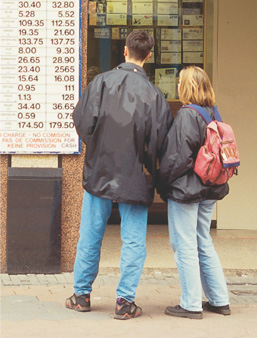Section 3 Measuring Trade
Preview
Objectives
After studying this section you will be able to:
- Analyze how changes in exchange rates of world currencies affect international trade.
- Describe the effect of various exchange rate systems.
- Analyze the effects of changes in exchange rates on the balance of trade.
Section Focus
International trade is complicated by the fact that different nations have different currencies. Countries pay for imports in their own currencies and receive foreign currency for exports. If a nation imports more than it exports, or vice versa, a trade imbalance is created.
Key Terms
- exchange rate
- appreciation
- depreciation
- foreign exchange market
- fixed exchange-rate system
- flexible exchange-rate system
- trade surplus
- trade deficit
- balance of trade
Have you ever traveled to a foreign country? If so, you may have been unable to purchase goods in that country using U.S. dollars. Similarly, tourists buying goods in the United States need to exchange their home country's money for U.S. dollars. In order for foreign visitors to buy something in another country, they usually must obtain that country's currency before making any purchases.
Exchange Rates
International trade takes place whenever a good or service is produced in one country and sold in another. Trade between countries is more complex than buying and selling within the same country because of the world's many currencies and their changing values.

Tourists can exchange their currency for that of the country they are visiting at currency exchange outlets or centers.
Foreign Exchange
If you want to buy a newspaper in Beijing, you will need to change your American dollars for Chinese renminbi. If a Mexican visitor to New York wants to buy lunch, she must change her pesos to dollars.
Changing money from one currency to another is not a simple matter of exchanging, say, one peso for one American dollar. A dollar might be worth 11 pesos—or 104 Japanese yen, or 8 Chinese renminbi.
The value of a foreign nation's currency in relation to your own currency is called the foreign exchange rate, or simply the exchange rate. The exchange rate enables you to convert prices in one currency to prices in another currency.
Reading an Exchange Rate Table
Exchange rates are listed on the Internet and in many major newspapers. Figure 17.8 shows a table of sample exchange rates. If you read down the first column, for example, you will see that one U.S. dollar can be exchanged for about one-and-a-quarter (1.28) Australian dollars, for a bit less than one euro (0.772), and so forth.
It is important to realize that these rates are what one U.S. dollar is worth on one particular day. Exchange rates go up and down daily.
Determing the Rate of Exchange
The following example will help you calculate exchange rates. Suppose your family is planning a trip to Mexico this summer and wants to determine the cost of staying in a hotel.




